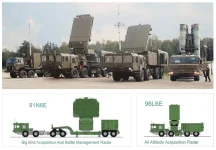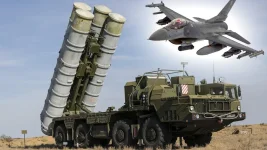- Views: 3K
- Replies: 5
Recent combat incidents in the Ukraine conflict, reportedly involving the downing of Ukrainian fighter jets, including advanced F-16s, by Russia’s S-400 Triumf air defence system, are highlighting the system's potent capabilities.
These events carry significant implications for the Pakistan Air Force (PAF), which operates a large fleet of F-16 and JF-17 aircraft. With India deploying the same S-400 system along its borders, military analysts suggest that routine PAF flight operations near these frontiers now face unprecedented risks.
India's positioning of the S-400 system necessitates a fundamental review of Pakistan's air combat strategies, as the missile system's demonstrated effectiveness reshapes the air defence environment in the subcontinent.
Reports emerging from the conflict zone detail the S-400's performance. Notably, an engagement in February 2022 reportedly saw a Ukrainian Su-27 destroyed over Kyiv from a distance of 150 kilometres, setting a record for such long-range air defence actions.
More recently, on April 12, 2025, claims surfaced regarding the neutralisation of a Ukrainian F-16, underscoring the S-400's ability to counter sophisticated Western aircraft equipped with modern electronic countermeasures.
These successes are attributed to the system's long-range missiles, like the 48N6 variant with a 250-kilometre reach, and its advanced networked radar systems, which enable dominance over vast areas of airspace. The proximity of major PAF air bases, many situated within 100 to 200 kilometres of the Indian border, places them well within the S-400's engagement envelope.
India has actively integrated the S-400 into its defence network. By early 2025, three out of five contracted squadrons were operational, strategically placed along the Line of Control (LoC) and the international border with Pakistan, particularly in the Punjab and Rajasthan sectors.
Known locally as "Sudarshan," each Indian S-400 squadron typically includes multiple launchers capable of engaging up to 36 targets at once. Utilising its longest-range missile, the 40N6, the system can theoretically strike targets up to 400 kilometres away.
Furthermore, its powerful radar systems (like the 91N6E and 96L6E) are designed to detect fighter-sized aircraft at distances between 400 and 600 kilometres. This means PAF aircraft such as the F-16 Block 52 or the JF-17 Thunder could potentially be detected almost immediately upon takeoff from key forward bases like Sargodha or Kamra.
A retired Indian Air Force official commented that the S-400's reach effectively covers nearly all of Pakistan's primary airfields close to the border, allowing India to counter threats deep within Pakistani airspace.
This advanced capability challenges Pakistan's traditional air strategies, which have included tactical border incursions and the use of standoff weapons, similar to actions observed during the 2019 Balakot incident where PAF F-16s briefly crossed the LoC. The integration of the S-400 into India’s broader Integrated Air Command and Control System (IACCS) significantly alters this dynamic.
An Indian Air Force exercise in July 2024 reportedly showcased the system achieving a high success rate against simulated enemy aircraft. The S-400's ability to detect, track, and destroy incoming threats rapidly—potentially before they can launch their own weapons, like the CM-400AKG supersonic missile—makes previous tactical approaches extremely hazardous.
The system’s varied missile arsenal, including options optimised for agile targets (9M96E2, 120km range) and high-speed threats (48N6E3, 240km range), provides flexibility against a wide spectrum of aerial targets.
The Pakistan Air Force faces difficulties in effectively countering the S-400. While Pakistan possesses electronic warfare (EW) equipment and other air defence systems, such as the Chinese-origin HQ-9, these are generally considered less effective against the S-400's sophisticated, networked, and jam-resistant radars.
Online discussions among defence observers in Pakistan reflect this concern, with some advocating for investment in alternative technologies like hypersonic missiles or stealth aircraft to bypass the S-400 threat.
However, Pakistan's development of next-generation platforms, such as the Project Azm stealth fighter, is understood to be a long-term endeavour, and its current aircraft inventory lacks the low-observable characteristics or advanced EW suites needed to reliably evade the S-400's comprehensive detection capabilities.
The experiences in Ukraine also provide lessons about the vulnerabilities of even modern Western aircraft when facing systems like the S-400. The F-16, despite numerous upgrades over its service life, reportedly faces challenges against the S-400's capacity to detect and engage targets, even low-flying ones, at extended ranges (potentially over 400 km), especially when the S-400 operates in coordination with airborne early warning aircraft like the A-50, as observed in Ukraine.
India intends to further enhance its air defence network by integrating the S-400 with its own airborne warning systems (AWACS) and upcoming indigenous long-range surface-to-air missiles developed under Project Kusha, expected around 2028. This aims to create a dense, multi-layered air defence shield that could severely restrict PAF air activity during any potential conflict.
Military planners in Pakistan must confront this evolving situation. The S-400's proven combat performance signifies that any attempt at aerial intrusion near Indian borders could lead to severe aircraft losses, thereby constraining the PAF's operational scope and ability to project air power.
With India expected to receive its final two S-400 squadrons by 2026, the strategic balance in the air domain appears increasingly solidified, compelling Pakistan to reassess its aerial posture and strategy.




